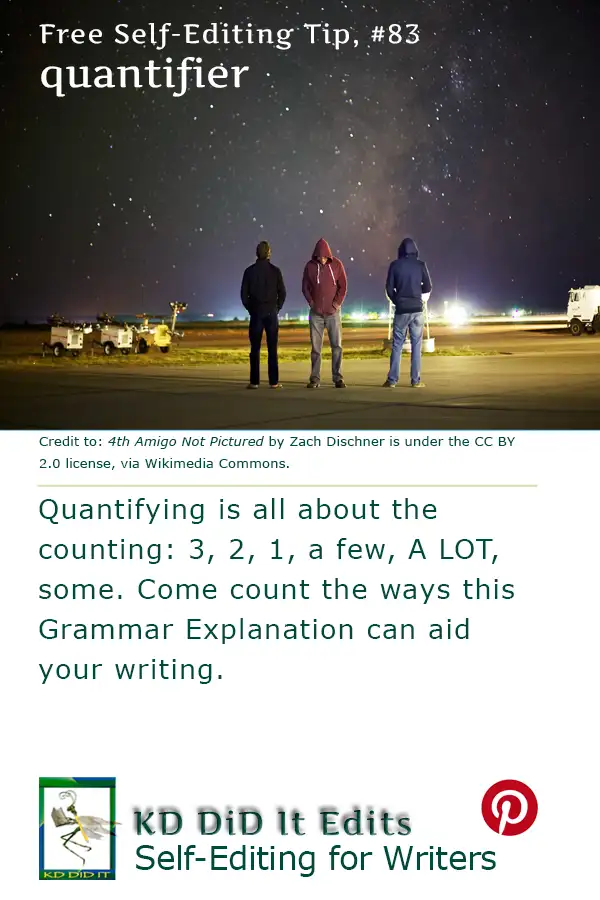Quantifier is a fancy way to say “count”. Now, whether it’s an exact count (a definite quantifier) or a general idea of lots, few, or some (an indefinite quantifier) depends upon the context or the idea you want to provide your reader.
Grammar Explanations is . . .
. . . an evolving list of the structural rules and principles that determines where words are placed in phrases or sentences as well as how the language is spoken. Sometimes I run across an example that helps explain better or another “also known as”. Heck, there’s always a better way to explain it, so if it makes quicker and/or better sense, I would appreciate suggestions and comments from anyone on an area of grammar with which you struggle or on which you can contribute more understanding.
If you found this post on “Quantifier” interesting, consider subscribing to KD Did It, if you’d like to track this post for future updates.
| Quantifier | |||||||
| Definition: A word, number, or phrase that usually precedes a noun and tells how much or how many there is of something.
See “Nouns” for details on countable and uncountable nouns. |
|||||||
| List of Indefinite Quantifiers | |||||||
|---|---|---|---|---|---|---|---|
| Use with Countable & Uncountable Nouns | Use Only with Countable Nouns | Use Only with Uncountable Nouns | Often Used with Abstract Nouns | ||||
| a load of a lot of all any enough less heaps of loads of lots lots of more most no none of plenty of some tons of . . . |
a couple of a large number of an both each either every (a) few fewer hundreds of many neither several thousands of . . . one, two, three . . . 1, 2, 3 . . . |
a bit of a little (not) much |
a good deal of a great deal of a large amount of |
||||
| Example Sentences | |||||||
|
Legend:
Mark ate three huge desserts It was just a bit of fun. We’ve spent a good deal of time on this. There are many trees in a forest. |
|||||||
| Noun Goes After Quantifier | Rule: When speaking of members of a group in general, put a noun after the quantifier. | ||||||
| Examples: | |||||||
|
Legend:
Few tulips emerged. Both the tulips and roses were beautiful this year. Is it possible to have enough flowers? |
|||||||
| Specific Group | Rule: When speaking of a specific group of people or things, use of the. | ||||||
| Examples: | |||||||
|
Legend:
Few of the tulips are still alive. All of the rosebushes bloomed this summer. Is it possible to have all of the flowers you want? |
|||||||
| Two People or Things | Rule: When speaking of two people or things, use both, either *, or neither *.
* Only use with a singular verb. |
||||||
| Examples: | |||||||
|
Legend:
Both kids were grounded. You can have either ice cream or chocolate. I’m sorry, but neither Mary nor George can come play. |
|||||||
| Each, Every means All | Rule: Use each or every with a singular noun to mean all. | ||||||
| Examples: | |||||||
|
|||||||
| Using Number | Rule: The word, number, can be: | ||||||
|
|||||||
C’mon, get it out of your system, bitch, whine, moan . . . which words are your pet peeves? Also, please note that I try to be as accurate as I can, but mistakes happen or I miss something. Email me if you find errors, so I can fix them . . . and we’ll all benefit!
Satisfy your curiosity about other Grammar Explanations by exploring its homepage or more generally explore the index of self-editing posts. You may also want to explore Book Layout & Formatting Ideas, Formatting Tips, Grammar Explanations, Linguistics, Publishing Tips, the Properly Punctuated, Word Confusions, Writing Ideas and Resources, and Working Your Website.
Resources for Quantifiers
Some of these links may be affiliate links, and I will earn a small percentage, if you should buy it. It does not affect the price you pay.
Apple Dictionary
The Free Dictionary: gaff
Pinterest Photo Credits
4th Amigo Not Pictured by Zach Dischner is under the CC BY 2.0 license, via Wikimedia Commons.
Revised as of 23 Apr 2024
By: Kathy Davie

